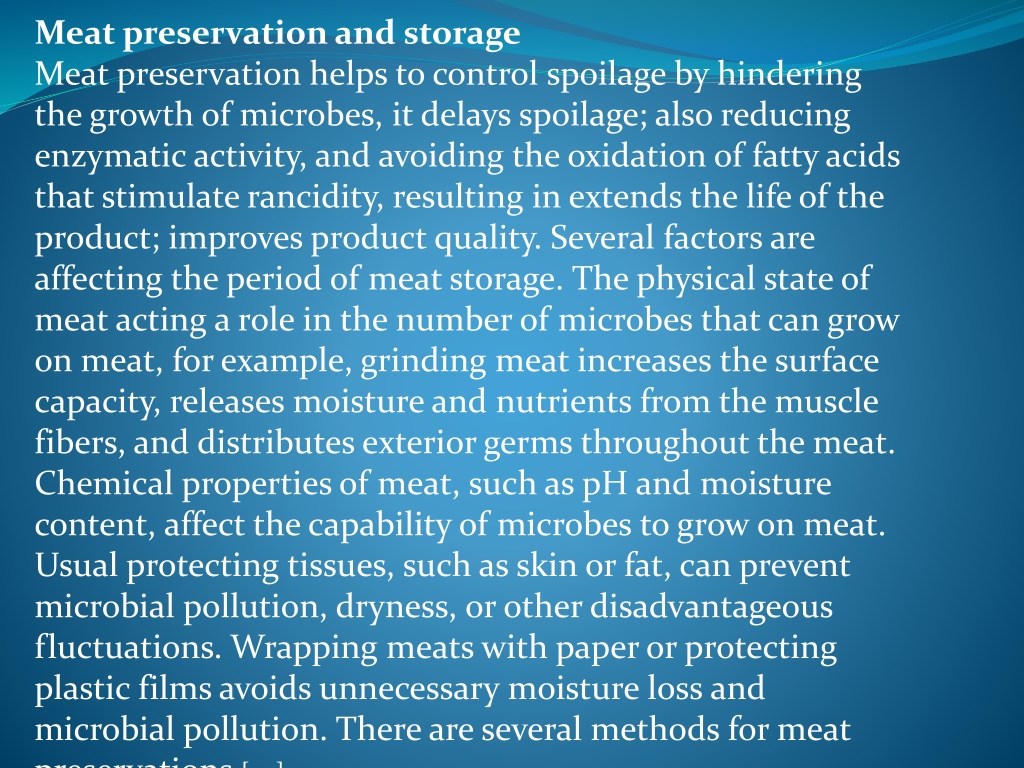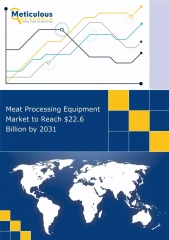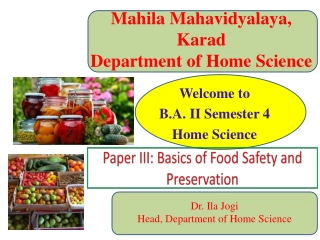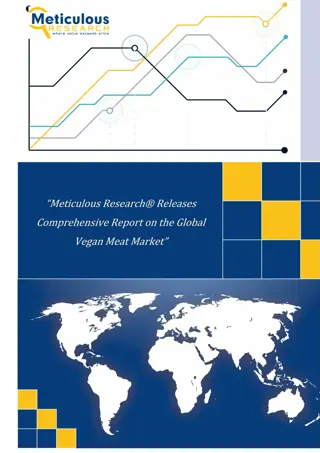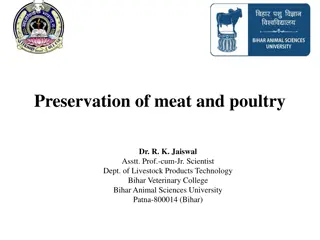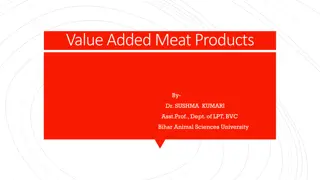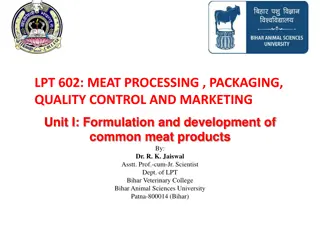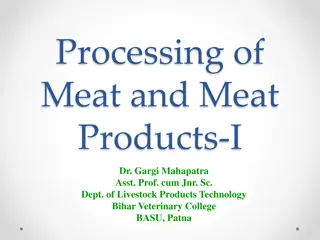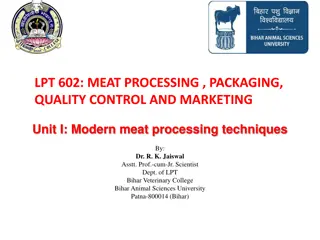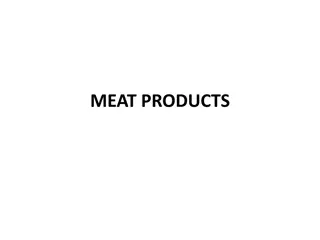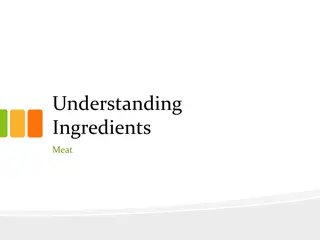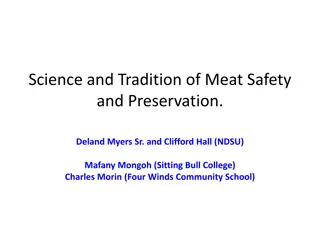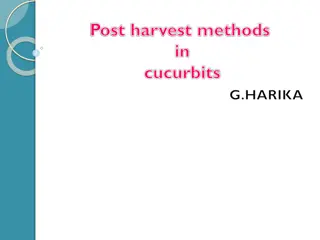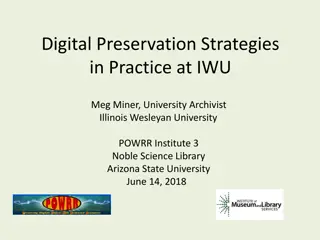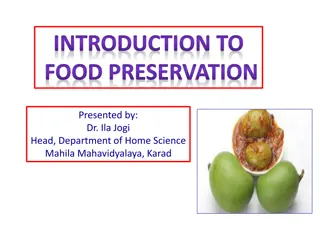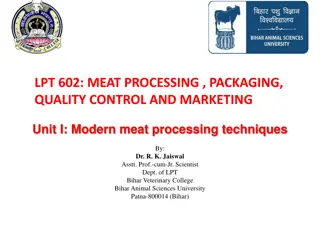Meat Preservation Techniques and Storage Methods
Preserving meat is essential to control spoilage and extend its shelf life. Factors like temperature, pH, moisture content, and packaging play crucial roles in meat storage. Methods such as chilling, freezing, curing, smoking, canning, and drying are commonly used to preserve meat, each offering unique benefits in inhibiting microbial growth and maintaining product quality.
Download Presentation

Please find below an Image/Link to download the presentation.
The content on the website is provided AS IS for your information and personal use only. It may not be sold, licensed, or shared on other websites without obtaining consent from the author.If you encounter any issues during the download, it is possible that the publisher has removed the file from their server.
You are allowed to download the files provided on this website for personal or commercial use, subject to the condition that they are used lawfully. All files are the property of their respective owners.
The content on the website is provided AS IS for your information and personal use only. It may not be sold, licensed, or shared on other websites without obtaining consent from the author.
E N D
Presentation Transcript
Meat preservation and storage Meat preservation helps to control spoilage by hindering the growth of microbes, it delays spoilage; also reducing enzymatic activity, and avoiding the oxidation of fatty acids that stimulate rancidity, resulting in extends the life of the product; improves product quality. Several factors are affecting the period of meat storage. The physical state of meat acting a role in the number of microbes that can grow on meat, for example, grinding meat increases the surface capacity, releases moisture and nutrients from the muscle fibers, and distributes exterior germs throughout the meat. Chemical properties of meat, such as pH and moisture content, affect the capability of microbes to grow on meat. Usual protecting tissues, such as skin or fat, can prevent microbial pollution, dryness, or other disadvantageous fluctuations. Wrapping meats with paper or protecting plastic films avoids unnecessary moisture loss and microbial pollution. There are several methods for meat preservations [95].
Chilling/refrigeration Temperature is the most significant factor in manipulating bacterial growth. Pathogenic bacteria do not grow well in temperatures under 3 C (38 F). So, meat should be stored at temperatures that are as cold as possible. Chilled packing is the most public method of meat preservation. The typical chilled packing life for fresh meats is 5 to 7 days.
Freezing Freezer storage is an excellent technique of meat preservation. It is significant to covering frozen meats carefully in wrapping that limits air contact with the meat to avoid moisture loss during packing. 10.3 Meat curing The commonly used technique of preserving meat before the days of chilling. It is done for communicating specific color and flavor development, as well as the preservative outcome. The main constituents comprise common salt (sodium chloride), sodium nitrate, sodium nitrite, and sugar.
Meat smoking Smoking and curing of meat are consistent. Smoke generation is accompanied by the creation of several organic compounds (aldehydes, ketones, organic acids, phenols, etc.) and their concentration products. Phenols act as bacteriostatic; formaldehyde as a bactericidal compound, also informing typical smoky flavor. 10.5 Canning Canning includes sealing meat in a container and then heating it to destroy all microbes capable of meat and meat products spoilage. Under normal circumstances, canned products can safely be stored at room temperature for an unspecified period.
Drying Oldest known technique of meat preservation. Drying removes moisture from meat products, lowers the water activity (aw) significantly so that microbes cannot grow. Freeze-dried meats, dry sausages, and jerky products are all examples of dried meats capable of being stored at room temperature without fast spoilage.
Irradiation Irradiation, or radiation, is a pasteurization technique achieved by exposing the meat to amounts of radiation. Irradiated fresh meat products still need cooling and wrapper to prevent spoilage, but the chilled storage life of these products is highly lengthy. Fermentation One early form of food preservation used in meat production is fermentation. Fermentation comprises the addition of confirmed safe bacteria to meat. These fermenting bacteria produce acid as they grow, lowering the pH of the meat and preventing the growth of several pathogenic microbes.
Vacuum packaging Oxygen is essential for various bacteria to grow. For this purpose, most meats are vacuum-packaged, which extends the storage life undercooled circumstances to about 100 days. Besides, vacuum packaging reduces the oxidation of unsaturated fatty acids and slows the development of rancid meat.
